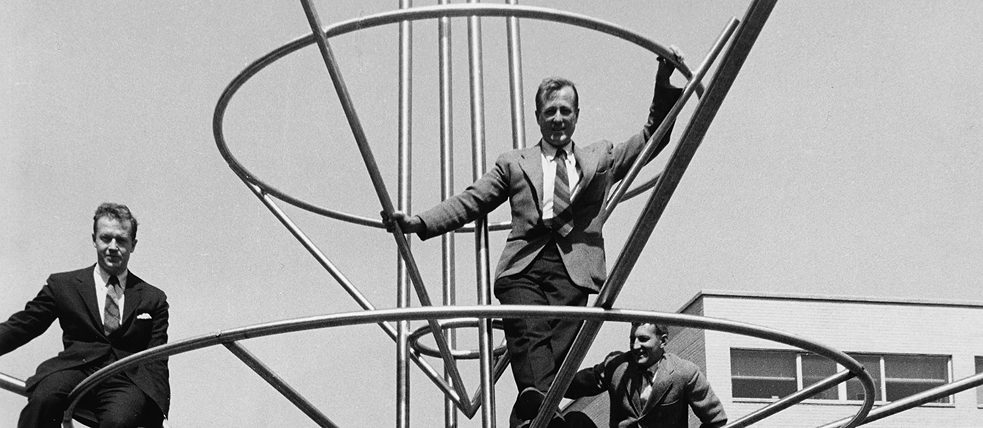A New Beginning
Walter Gropius and “The Architects Collaborative”

After emigrating in 1937, Walter Gropius (1883-1969) was able to pursue a second major career in the US and taught numerous students of the second and third generations. Remaining active well into old age, he ran an internationally successful firm of architects in Boston and Cambridge: “The Architects Collaborative”– or TAC for short.
By Arnold Körte
His legacy was a body of his own work that had long since become independent of Bauhaus, though it was based to some extent on his experiences there. The anniversary year of 2019 will see celebrations of “100 Years of Bauhaus”, which is an indirect yet understandable reason to take a look at the later Gropius from a different – transatlantic – angle.
From this perspective, the artistic and indeed ethical roots of a style such as the Cambridge Modern become clear – these are to a considerable degree the result of TAC’s individual approach to work and organization. In an architectural epoch that was subsequently dubbed “New Brutalism”, a productive generational conflict emerged without anyone at TAC being remotely conscious of any particular brutalism in their designs. It was not least Gropius’ legendary teaching that had paved the way for this: in 1938, long before the TAC was established in 1945, he had already reformed the way students were taught in his capacity as head of the Department of Architecture at the Harvard Graduate School of Design (GSD).
A Distant Influence of Bauhaus at Harvard
He was able there to design his own lessons in an open and discursive model in the Anglo-Saxon style. The juries that judged the student’s final graduation projects at Harvard and Yale engaged in lively and extremely entertaining intellectual discussions, pursued with complete respect yet certainly without pulling any punches. One could sense the distant influence of Bauhaus: not only was this passed on through individuals such as Gropius and his young colleagues, it was also able to evolve into something entirely new in the fertile soil of an elite university.This was the didactic substructure upon which TAC’s collective work approach grew to become a pool for highly-gifted architects from all over the world. Contrary to a popular myth, however, it was not Gropius himself who picked the seven partners with whom to collaborate. In fact, it was rather the reverse, four of the later partners having already been connected to one another via a network of personal and professional relationships. This network had formed in a climate of social and architectural optimism in the USA following the Second World War.
A World Collaborative
Norman C. “Fletch” Fletcher (1917-2007), Louis A. McMillen (1916-1998), Robert S. McMillan (1916-2001) and Benjamin C. Thompson (1918-2002) had all been students together at Yale, where they had already been planning a “World Collaborative” that was intended to be “an ideal firm” combining painting, sculpture and architecture. John “Chip” Harkness (1916-2016) and Fletcher had both been conscientious objectors; Jean B. Fletcher (1915-1965) and Sarah “Sally” P. Harkness (1914-2013) had studied at the Cambridge School of Architecture and Landscape Architecture, the first school of design to grant degrees to women in the US. Chip and Sally married in 1941, Jean and Norman in 1945.Almost all the same age, this group of friends had in other words already decided to work together in some collaborative way and were keen to recruit an experienced senior practitioner who could help them climb the first rung of the career ladder and lend a certain status to their young firm. And this is how Gropius came on board, a congenial comrade-in-arms who shared the same attitude toward teamwork as the others. The eight founders had no lesser goal than, in the words of Sally Harkness, “to remake the world”.
A Liberal, Unconstrained and Free Atmosphere
From today’s perspective, questions arise as to how this office community actually worked. After a hesitant start, it ultimately became a global operation with branches in Rome, Kuwait and San Francisco. TAC’s style of work differed from other architectural firms to the extent that a great deal of time was invested in the draft phase, with ever new variants and alternatives being designed. The atmosphere was casually liberal, unconstrained and free. The partners responsible for the respective projects gave employees a long leash, which was felt to be pleasantly typical of TAC, and indeed came to take for granted; though later, when the firm’s workforce peaked in its 1960s glory years, this relaxed approach gradually meant that efficiency suffered and it became hard to keep track of what was going on. What is more, when Gropius died in 1969 his ability to unify the firm was lost.TAC’s model of an anonymous but creative collective produced a wonderful oeuvre that quite rightly was also celebrated internationally – especially given the permanent mark left by the forward-looking school and campus buildings of New England. In the long run, however, the firm – whose structure was designed with a view to gaining knowledge rather than making money – did not have a solid foundation. When in its later phase millions of dollars’ worth of fees failed to materialize as a result of the Iraq War, its 1995 demise was clearly not far off. Nonetheless, it remains no mean feat that Gropius and his colleagues made TAC a forward-looking working model of “small-scale democracy” over a period of 50 years.